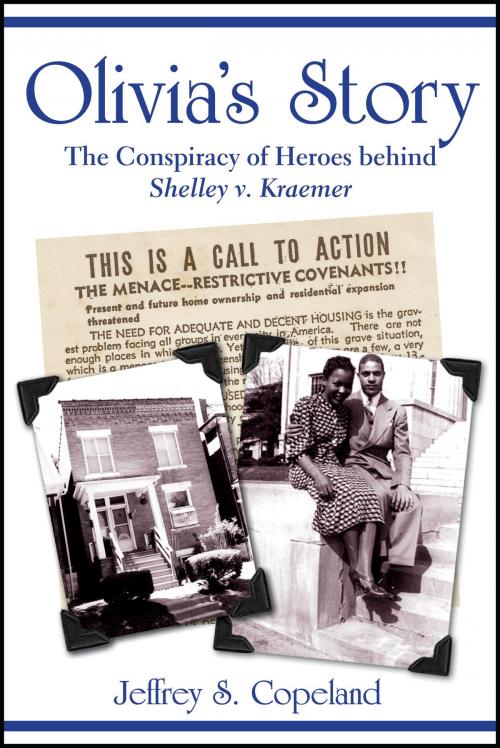Olivia's Story
The Conspiracy of Heroes behind Shelley v. Kraemer
Nonfiction, Social & Cultural Studies, Social Science, Discrimination & Race Relations, History, Americas, United States, 20th Century, Biography & Memoir, Historical| Author: | Jeffrey S. Copeland | ISBN: | 9781610830089 |
| Publisher: | Paragon House | Publication: | February 13, 2014 |
| Imprint: | Language: | English |
| Author: | Jeffrey S. Copeland |
| ISBN: | 9781610830089 |
| Publisher: | Paragon House |
| Publication: | February 13, 2014 |
| Imprint: | |
| Language: | English |
The story behind the landmark 1948 Supreme Court decision, Shelley v. Kraemer, which struck down racially-based housing restrictions and opened the door to fair housing regulations in the United States, told through the voice of an African-American teacher, one of the participants.
Many battles have been fought through the years to gain dignity, justice and equality for all in America. Few of those battles have had the lasting significance and impact of the one described in the telling of Olivia’s Story. Olivia Merriweather Perkins joined a brave group of people in St. Louis, Missouri who came together, without regard to their personal safety and well-being, to fight for rights that had been denied to people of color, the right to property. Their sacrifices eventually led to Shelley vs Kraemer, one of the most important legal battles of modern times, the impact of which was felt in every corner of America. This legal case changed the face of a nation, not only in housing but also in other area taken for granted today. The story behind the case shows the power of dreams and how these dreams can come true if people are willing to fight for them.
All major events of Olivia's Story are true. The details were gathered from archives, records centers, letters, and legal documents of the period. However, as important as these materials were, they did not present enough of the humanity inside the story. The human side was collected through visits to and interviews with many of the principle characters presented in the book, along with their children and other relatives, all of whom provided rich details of one of the alternately darkest and brightest periods in American history. These individuals included Margaret Bush Wilson and others who had personal knowledge of the events of that time and who worked through their lives to protect the liberties clarified through that famous court battle.
" Olivia’s Story is just that: a very personal narrative for which only the most gifted writer could find words. Mrs. Olivia Perkins was a quiet woman at the center of a history-making event, the challenge to restrictive covenants that led the way to fair and open housing not just in St. Louis but for all of America. Jeffrey S. Copeland uses her character and experiences to personalize the emotional and psychological elements of this struggle, a veritable second chapter to her life which for others might have closed with the death of her war-hero husband.
Great leaders have had their dreams, and brave figures have fought the good fight for civil rights and liberties. But it is the story of an individual like Olivia Perkins that tells the truth by putting the love and the sorrow, the suffering and the joy into 'true' but otherwise distant events."--Jerome Klinkowitz, author of Kurt Vonnegut’s America
The story behind the landmark 1948 Supreme Court decision, Shelley v. Kraemer, which struck down racially-based housing restrictions and opened the door to fair housing regulations in the United States, told through the voice of an African-American teacher, one of the participants.
Many battles have been fought through the years to gain dignity, justice and equality for all in America. Few of those battles have had the lasting significance and impact of the one described in the telling of Olivia’s Story. Olivia Merriweather Perkins joined a brave group of people in St. Louis, Missouri who came together, without regard to their personal safety and well-being, to fight for rights that had been denied to people of color, the right to property. Their sacrifices eventually led to Shelley vs Kraemer, one of the most important legal battles of modern times, the impact of which was felt in every corner of America. This legal case changed the face of a nation, not only in housing but also in other area taken for granted today. The story behind the case shows the power of dreams and how these dreams can come true if people are willing to fight for them.
All major events of Olivia's Story are true. The details were gathered from archives, records centers, letters, and legal documents of the period. However, as important as these materials were, they did not present enough of the humanity inside the story. The human side was collected through visits to and interviews with many of the principle characters presented in the book, along with their children and other relatives, all of whom provided rich details of one of the alternately darkest and brightest periods in American history. These individuals included Margaret Bush Wilson and others who had personal knowledge of the events of that time and who worked through their lives to protect the liberties clarified through that famous court battle.
" Olivia’s Story is just that: a very personal narrative for which only the most gifted writer could find words. Mrs. Olivia Perkins was a quiet woman at the center of a history-making event, the challenge to restrictive covenants that led the way to fair and open housing not just in St. Louis but for all of America. Jeffrey S. Copeland uses her character and experiences to personalize the emotional and psychological elements of this struggle, a veritable second chapter to her life which for others might have closed with the death of her war-hero husband.
Great leaders have had their dreams, and brave figures have fought the good fight for civil rights and liberties. But it is the story of an individual like Olivia Perkins that tells the truth by putting the love and the sorrow, the suffering and the joy into 'true' but otherwise distant events."--Jerome Klinkowitz, author of Kurt Vonnegut’s America















